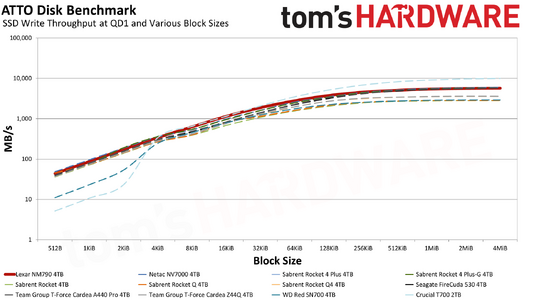Just reading this review and I'm a little confused by the sustained write performance and the subsequent average steady state MB/s results:
In the sustained write graph over 900 seconds the Teamgroup A440 seems to be one of the best performing drives, writing at 7000MB/s for around 60 seconds, then 4000MB/s until near the end of the test (maybe 860 seconds, or just over 14 minutes, when it drops to 1700-1800MB/s.
But then in the following chart, the same drive is shown with a "Average Steady State after 15 minutes" of just 1550MB/s:
And, in fact, if we do the maths from the slightly different charts on the A440 Pro Review:
3574GB written over 15 mins/900secs = 3941MB/s average.
The only thing I can think is that you aren't taking the average over the entire period, but an average of the last few seconds - but even in this case it doesn't seem to line up with the graph, which seems to show over 1550MB/s even in the very last part of the write. However, if this is the case, I would be interested to know why this is considered a useful enough metric to be one of the included graphs in the review.

 Anyway, ATTO is very much synthetic and I wouldn't depend too much on its results as a true indicator of performance. What it really shows is how performance scales with larger block sizes and reads/writes. I think a lot of SSDs are tuned for maybe 256KB blocks, or at least they'll do way better at 256KB than at 4KB.
Anyway, ATTO is very much synthetic and I wouldn't depend too much on its results as a true indicator of performance. What it really shows is how performance scales with larger block sizes and reads/writes. I think a lot of SSDs are tuned for maybe 256KB blocks, or at least they'll do way better at 256KB than at 4KB.



